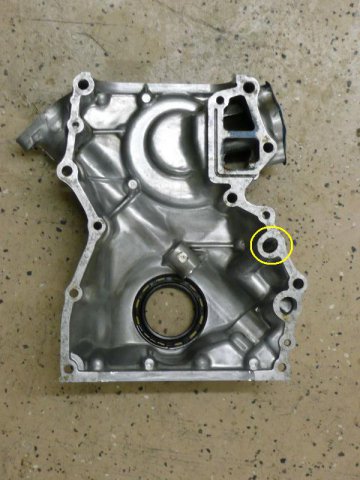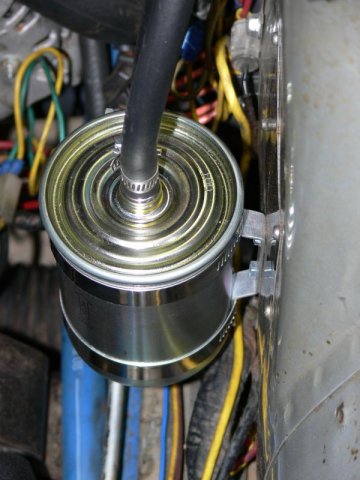-
Posts
1568 -
Joined
-
Last visited
-
Days Won
1
Content Type
Profiles
Forums
Blogs
Events
Gallery
Downloads
Store
Everything posted by Zmanco
-
Tony, thanks for the discussion of how the factory system works. I guess you're suggesting that the best approach is to use the factory canister. That may indeed be the best solution, but I was hoping in true hybridz fashion, that someone had found an alternative canister that was more readily available at the pick-n-pull, or even better would be a way to use the toyota one I already have.
-
I think you're confusing a downpipe with a wastegate. I am still a turbo noobe, but it looks like your turbo is designed to bolt up to an internal wastegate which then bolts to the down pipe. In my case the wastegate from the stock t3 would not match up to the new t3/t4 even though they were very similar. In fact, in the pictures it looked like it would fit, but the holes were off by fractions of an inch. I dont' think my downpipe is going to work for you. Edit: meant internal wastegate.
-
It depends on the internal wastegate. The turbo I bought was a Garret t3/t4 but the wastegate wasn't the same as the Datsun t3 so the downpipe wouldn't bolt up.
-
I've had the same thing happen a few times: big spikes in the datalog and nothing felt from the drivers seat. Hasn't happened often enough for me to chase it down. I'll be curious what you learn. BTW, which version of MS are you using?
-
I've got one of these: http://www.thezstore.com/page/TZS/CTGY/PEC20 I bought it when I thought I was going to use the stock T3 turbo, but went with a different turbo instead. It has not been installed. $70 plus shipping.
-
Tony, good suggestion to look at the FSM for the factory car. Attached are the relevant pages and it looks like the purge valve is in the canister itself. However, I don't have a turbo canister (and they're not very plentiful) so this path may not work for me. Any thoughts about putting a vacuum check valve in line with a 2 port canister to prevent applying positive pressure to the canister when under boost? Or does it matter? Right now max boost is about 10 psi and I don't expect to go over 15 when I finish tuning. The toyota canister is well constructed so maybe letting the pressure go positive under boost isn't an issue? Am I making this too hard? efec pg 41.pdf efec pg 122-125.pdf
-
I was thinking of trying a mechanical gauge, but remembered a discussion about the sensor threads being BPT. Anyone know of a kit that uses a BPT sensor, or know where I can find a BPT to NPT adapter? EDIT: I just found this on Summit: http://www.summitracing.com/parts/ATM-2269/. BSPT is the same thing as BPT, correct? Would this fit L6 block? As for the leak being a sealing issue between the cover and block, I initially thought that and hence tried a different (and known-good) cover. I'm now wondering about the block surface, but it looked good when I had the cover off, and I scraped it with a razor and cleaned with solvent to be sure it was pristine. So I'm not sure what I would do next assuming it's not an excessive pressure issue? Any suggestions?
-
As I said in another post, I'm in the final stages working out a few issues after going turbo. Quick recap: I picked up an engine pulled in 1982 from a 280zx turbo with less than 100 miles. I already had a P90 head, intake manifold, megasquirt etc. So basically all I used from the turbo motor was the bottom end (untouched) with its oil pump and the timing cover. For the first 1700 miles all was good and then suddenly I noticed I had oil pooling on the bottom of the oil pump. It seemed to be coming from below the water inlet on the passenger side but there was no obvious source. Eventually I determined that it was seeping between the timing cover and block. So I pulled the cover off hoping to see that I had damaged the gasket or something. But alas there was no visible damage in any way. So I used the old timing cover from my previous engine and used it. Well, the leak remains, albeit not as much. So now I'm thinking that the oil pressure may be too high. My oil pressure gauge (I know - on the 73's they are notoriously inaccurate) reads about the same as with the old motor which I expected since I had moved the old sending unit over to the new motor. Still, I pulled the over-pressure valve and spring out of the new oil pump and they looked fine. As an experiment I put the old engine's spring in yet the pressure still reads the same and the seepage continues, although it's not as bad as it was before I changed the timing cover. So to recap, - For the first 1500 miles there was no oil leak at all - Suddenly the seepage began - The seepage continues with the replaced timing cover - Putting an old pressure spring into the "new" oil pump didn't solve it. If you look at the picture of the timing cover, you can see where I circled the output of the pump back into the block. That's right where the oil is seeping which makes me think my oil pressure might be too high. But why that be the case even with the old spring? What am I missing? FYI, I have an oil cooler using one of the Earl's fittings that sandwiches between the oil filter and block. But this was all installed before the swap and never gave me any problems so I'm assuming it's not the issue here. Suggestions?
-
I'm sorting out some of the smaller remaining issues now that I've got the turbo install finished on my L28 and need advice on how others are handling venting the gas tank on their early S30s. Before I added the turbo I had picked up a charcoal canister from a toyota at the picknpull and had one port connected to the fuel vent line up in the engine compartment and the other end directly to the intake manifold. This setup worked very well - I never smelled fuel in the garage and there was never any significant pressure released when I opened the gas cap. When I installed the turbo I ran out of space to keep the canister where I had it. I was also worried about going above atmospheric pressure in the canister. So I just plugged vent line in the engine compartment and left the canister off. Of course, now sometimes when I open the gas tank there is huge release of pressure, I mean huge! So it's time for me to mount the canister again, but I'm wondering how to plumb it into the intake manifold. I'm thinking about adding a one-way valve in line back to the intake manifold. That way as pressure builds in the tank it could vent into the intake manifold, but when boost goes above atmospheric, the valve would prevent the pressure from going back into the canister. Does this sound realistic? And where can I find a valve like this? I figure this problem has already been solved by others so I'm hoping to not have to do too much inventing
-

Eibach or Tokico Lowering Springs?
Zmanco replied to kevingorby's topic in Brakes, Wheels, Suspension and Chassis
What are your plans for driving the car? Any autocross or track use? Is this a daily driver for you, or a weekend toy car? I think most people use the Illuminas because they are really the only reasonably priced adjustable shock still available. If you like to fiddle with settings, and also play around with tire pressures, then you'll probably enjoy the illuminas. But if you prefer to put it in, set it, and forget it, then go with the Blues. The main advantage of the Illuminas is that you can set them firmer for aggressive driving (track and autocross) and then soften them back up for driving on the street. I have a friend with Blues and Tokico springs in his 260 and they felt something like the 1 or 2 setting on the Illuminas. So the Illuminas let you go firmer for special occasions, but I don't think you'd want to drive that way on the street regularly. And I don't think our 30+ year old unibody chassis would survive it over time either -
There's an interesting article in this month's Car and Driver that compares performance across 4 Michelin tires ranging from high performance all season to their X-Ice tire. Interesting conclusions about which performs best in dry, wet, snow, and ice. Definitely worth a read if you live in snow country. BTW, we have the Michelin Arctic Alpin on 2 of our cars and have had good success with them. They're not too bad in the dry, and still very good in snow. Ice is good enough, but not as good as the X-Ice tire. I think we're going to get 3 seasons (Nov - March) per set out of them without having to run the tread too shallow.
-
Derek, as always your work is fantastic. I've got the same fans as you I think but mounted without a shroud. So far they've been adequate in hot summer traffic, but after the turbo conversion they are just barely adequate. In stop/go summer traffic they're on more than off, although in fairness temps never go above 200. I've always thought that a shroud would improve low speed cooling a lot. But I've also wondered about track running. It seems to me that the shroud would restrict airflow at higher speeds, although I don't know if the restriction would be significant, or too small to matter. I know we're heading into winter, but have you had a chance to gauge if/how this impacts airflow "at speed", especially with extended periods of running WOT on warm days?
-

DIY bump-steer adjustable tie rod ends.
Zmanco replied to thehelix112's topic in Brakes, Wheels, Suspension and Chassis
Thanks Jon, that explains how this will enable adjusting bump steer. -
The last one I bought was from Courtesy Nissan, although that was a few years ago.
-

DIY bump-steer adjustable tie rod ends.
Zmanco replied to thehelix112's topic in Brakes, Wheels, Suspension and Chassis
I apologize in advance if I'm being a bit dense with this question, but how is this different from the stock tie rod end as far as bump steer is concerned? Unless you move the attachment position of the steering knuckles to the tie rod end, isn't this just the same as the stock geometry? What am I missing? BTW, I've been known to use a vice grip for a tap too, although I've also successfully used a socket. -
-
Indeed, love the engine note. But what's up with the transmission? Seemed like he had a problem getting it into 1st at the start of the race, but as he was approaching 1st gear corners, he just threw it into 1st with no double clutching. My gearbox just wouldn't allow that at that speed. It looks like he's in Japan - perhaps he has a different transmission than what we have in the US? It's a tight course too, seemed like he barely spent any time in 3rd gear - almost all in 1st and 2nd. Fun videos - thanks.
-

Eibach or Tokico Lowering Springs?
Zmanco replied to kevingorby's topic in Brakes, Wheels, Suspension and Chassis
The front springs from Tokico are progressive and on some cars most of the coils bind resulting in bottoming out on big bumps. I'm not sure why it only occurs on some and not others. FYI, I have them on my 73 with Illuminas and it's a good combination for the street. And for "casual" track use with the struts stiffened up (4 front, 5 rear) they're not bad, but not as stable as I'd like at higher speeds, say over 80. Basically they're good for street and mild track use. I haven't tried Eibachs nor do I know anyone who has so can't help there. -
John, what are your thoughts on how much torque/HP is safe to put through an R180 with stock 240z half shafts that is NOT used for drag racing? In other words, the launches will all be reasonable (no drop clutch at redline, etc) and the car is driven on the street and/or road course? Assume it has a CLSD if that makes a difference.
-
Z31Guy, please start a separate thread. Your question doesn't add to the main topic of this thread which is how to get started planning with Megasquirt.
-

Broke the head off a valve/crank cover bolt. What do I do?
Zmanco replied to fisheric's topic in Miscellaneous Tech
If the head and valve cover are both straight, then a fresh gasket is probably the only way to stop the leak. In my experience with an L6, once the gasket starts to weep/leak, tightening the bolts more only distorts the gasket and causes further leaks. I know you said that you're trying to do this on the cheap, but you may just have to live with a little oil leaking until you can replace the gasket. IIRC, the valve cover bolts are spec'd at 6 lb-ft. Make sure that when you do replace it, that you don't go beyond that or you'll shortly be right back where you are now. -
It might be the seals on each side of the rear main bearing cap. Not sure if you could replace those with the engine in the car ...
-
An early 90's Honda fan is a bolt in replacement (save the wiring connector) for 73 and earlier S30s and moves more air with less noise. Perhaps that's an option for your 76?
-
I'd think twice before I put the MSA exhaust on again. In my case it was not exactly a "bolt on" and by the time I had paid my local muffler guy to make it fit, for the same money I could have had him build a full custom. This was on a 73 240Z with their 2.5" kit paired with their 6:1 header. I can't speak for the 280zx. Also the Dynomax muffler doesn't have a bad sound, but it's nothing special either. Most people seem to prefer a deeper sound like the Magnaflow.
-
Would that be the bike equivalent of "car control"? He makes it all look so easy...


